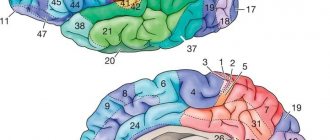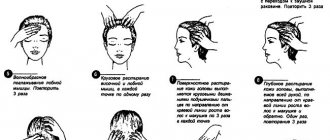It has been proven that the female brain is approximately 8-12 percent smaller than the male brain, which, however, does not mean that the fairer sex is naturally dumber. Nevertheless, there is a difference. Male and female brains perceive some things differently. Researchers have learned why this happens and what is the main difference between the brains of men and women.
Are there differences?
For centuries, debates about the difference in thinking, behavior and perception of situations between men and women have not subsided. But if earlier discussions were more like accusations with nothing behind them, today this topic can be seriously debated, based on real scientific facts.
For the most part, gender differences between men and women are the result of the structure and functioning of the brain. It is on this that the cognitive and behavioral differences inherent in both sexes depend. There was a time when researchers even talked about the “field” of the brain. Proponents of this theory argued that the brains of all men work according to a generalized scheme, while the gray matter of all women has its own unified “program”.
Content:
- Are there differences?
- Weight and volume
- Development of the hemispheres
- Verbal skills
- Perception
- Stress
- Memory
- Teamwork
- Sexual behavior
- Our brains shrink in different ways
- So why are we so different
True, over time this theory had to be abandoned. This is because, as it turns out, there are almost no purely “female” or purely “male” brain types in nature. Although scientists do not deny the fact that the “control center” of the weaker and stronger sex has certain gender characteristics.
An international team of researchers observed the behavior of almost 500 thousand people of different ages for many years, and also studied approximately 2.5 thousand MRI images of the brains of men and women aged 44 to 77 years. This allowed scientists to make a number of amazing discoveries. Experts were able to examine and measure 68 different areas of the central nervous system. The results showed that women tend to have a thicker cerebral cortex than men, but the stronger sex has a larger brain.
Women are also more likely to suffer from dementia.
“Typically, women's memories are longer than men's,” says Dr. Amen. His research indicates increased activity in the hippocampus in a woman’s brain, which is the area responsible for long-term memory. However, the statistics for older people favor men: only 5% of them suffer from some form of dementia, while for women the figure is 7%. In addition, when comparing two patients of different sexes with Alzheimer's disease, it turns out that women experience mental regression faster than men, and 20% more women die from this disease than men.
Scientists believe that estrogen and testosterone (female and male sex hormones) have different effects on the brain. “We are only beginning to understand how important differences in brain function between men and women are in explaining the well-known gender discrepancies in the onset and course of Alzheimer's disease,” says Catherine Abel, professor of psychiatry at the University of Manchester. “Men have half the risk of the disease compared to menopausal women, and women with Alzheimer's disease regress faster,” says Pauline Mackie, a professor of psychology at the University of Illinois at Chicago and an expert on the relationship between hormones and dementia. She believes that estrogen levels are associated with the risk of Alzheimer's disease.
Professor Mackie summarized data on women who entered menopause early (before age 48) as a result of ovary removal surgery. The risk of developing Alzheimer's disease in this group is 70% higher than average. “Estrogen protects women's brains from degeneration. In men, testosterone performs the same function. However, testosterone levels in men do not fall as sharply as estrogen levels in women, says Pauline Mackie. This is why women are more prone to dementia in old age than men.
Keith Laws, professor of cognitive neuropsychology at the University of Hertfordshire, said women's higher risk of dementia is also due to the fact that they are more likely to withdraw from professional activities than men, and often devote themselves to home life and raising children. He and his colleagues analyzed 15 studies involving 2,000 patients of both sexes with Alzheimer's disease. “We found,” he says, “that brain function was impaired more strongly and to a greater extent in women than in men. For one reason or another, men are able to resist the ravages of the disease longer. We are still studying these reasons, but one of our assumptions is that men have better “cognitive reserve” because in the generation that has now reached the age considered at risk for Alzheimer's disease, a fairly large proportion of women remained housewives, while men engaged in work activities that kept their brains active. As a result, they are better able to resist dementia.”
Weight and volume
The first and most obvious distinguishing feature between male and female brains is the physiological structure of the organ. Firstly, in men it is about 100 g heavier and also larger in volume. True, researchers often explain this fact not so much by the characteristics of the organ itself, but by the general physiological characteristics of the human body.
Men's bodies are, in principle, larger and more voluminous than women's. This may be why the stronger sex has a larger brain. As evidenced by modern science, this characteristic does not in any way affect cognitive or other abilities. Just remember the brain of a Neanderthal. It was much more significant than that of a modern person. But did that make him smarter? Therefore, experts emphasize that for good brain function, it is not its volume and weight that is important, but the quality of connections between neurons.
It is also interesting that different parts of the male and female brain also differ in parameters. For example, young ladies have a larger right frontal pole, pars triangularis, inferior and middle frontal gyri, temporal plane, anterior part of the cingulate gyrus and left parahippocampal, parietal operculum, insular cortex, thalamus, Heschl's gyrus, precuneus, as well as the lateral part of the occipital cortex. bark. In males, the hippocampus, tonsils, posterior part of the cingulate and anterior part of the parahippocampal gyri, temporal poles, putamen and some areas of the cerebellum are larger in size.
Size
The average man's brain is 8–13% larger than that of the average woman.
But we are talking about absolute figures without recalculating body weight. Considering that the average height and weight of men is also higher, this is not surprising. Given the same parameters, there is a high probability that the brain will weigh the same. However, this is a case where size really doesn't matter. In men, the brain weighs on average 1.345 Reader in Gender Archeology kg, in women - 1.222 kg. An elephant's brain weighs 4.6 The elephant brain in numbers kg, but you are unlikely to consider it a serious opponent in an intellectual duel. By the way, Albert Einstein's brain weighed 1.23 kg.
Development of the hemispheres
Many people probably know that the left hemisphere of the brain is responsible for rational thinking, logic and the ability to analyze. The right controls emotions and intuition. Both of them are developed differently in men and women. Most likely, most of those reading these lines thought that the left side of the brain is more developed in males, and the right - in females. And they were wrong.
The hemispheres of the brain in men and women are actually developed differently. Even in the womb, boys’ left hemisphere develops more slowly, but the right hemisphere “gains weight” relatively quickly. Experts suggest that this is due to the effects of testosterone. But for women, both hemispheres are equally involved in their work. As a result, it is easier for women to manage skills characteristic of the left hemisphere (verbal skills, communication), while men have more developed abilities that are controlled by the right side of the brain (active action, competition).
This feature of the brain structure affects the ability of the sexes to demonstrate spatial and social skills. Men are more focused on developing spatial thinking; it is easier for them to perceive reality and quickly coordinate their actions with it. The structure of the female brain is designed for the development of social skills, work in an analytical and intuitive mode, as well as multitasking (performing several tasks at the same time).
The difference also exists at the cellular level. In women's brains, nerve cells are located closer to each other than in men's. And this feature is crucial when it comes to the speed of signal transmission between different parts of the brain. In addition, in men, individual areas within the hemisphere “communicate” more closely, while in women interhemispheric connections are more developed. This is explained by the fact that in young ladies the right and left hemispheres are connected by denser nerve fibers than in men. This factor influences the features that we will discuss further.
Conclusions: more questions than answers
Are women really better coders?
Could it be that, due to the attitudes of society, only those who truly have talent, perseverance and ability make it into the profession? Even if the brains of men and women are significantly different, does this affect the ability to learn technical sciences?
Be that as it may, support your close girls in their desire to become good programmers - and let's see how the situation will change in 30-40 years and time will put everything in its place.
Links to studies:
Gender differences and bias in open source Two minds. The cognitive differences between men and women
Verbal skills
They even tell jokes about the fact that all women are great lovers of talking. But as it turns out, the desire to chat among the fair sex is inherent in nature itself. And again, it’s all about the structural features of the central nervous system.
We have already said that the cerebral hemispheres of the sexes are developed unequally. Hence the difference in working with verbal information. To “digest” what they hear, women use both hemispheres at once (including the left, responsible for the perception of verbal information). Men tend to do this predominantly on the right.
In addition (and we have also already talked about this), both hemispheres in the female body are connected with the help of powerful nerve fibers, due to which a more effective exchange of information occurs. In the male head, nature used thinner fibers for this purpose. By the way, it is precisely the structural features of the fibers connecting the hemispheres that doctors explain why women, as a rule, more easily restore verbal skills (speech) after a stroke.
This same feature of brain design explains why boys begin to speak and read later than girls.
But why did nature decide that verbal skills should be developed differently in both sexes? The theory explaining these differences was put forward by the American psychologist J. Levy. According to his hypothesis, the reason for everything is evolutionary processes. The main task of the primitive man was to hunt. And for this it was vitally important for him to navigate well in space, and not to talk.
As for the woman, even in the Stone Age she was the keeper of the hearth, took care of children and created family comfort. It was important to exchange experiences and resolve issues with other women. And in this she was helped by communication skills, which in the course of evolution were more improved along with the left hemisphere of the brain.
Here's why men don't follow doctors' advice
Last year, scientists at the University of Michigan conducted an interesting study: they analyzed how men and women react to a variety of health messages. When showing posters advertising exercises, the best motivator for men was the opportunity to lose weight and improve physical health, for women it was the opportunity to increase their sense of satisfaction with life and a sense of well-being.
“We know that the male brain responds better to visual information, including in advertising. Women are more attentive to detail and absorb the whole picture,” says Dr. von Loeb.
Dr Amen believes women are more likely to respond to calls to take care of their health and visit the doctor more often, not least because they plan their activities better and are generally more diligent than men.
“Women have more cells in the prefrontal cortex, which is the area that controls judgment, planning and conscientiousness when performing an action. This same area is responsible for impulse control, which explains why women are more likely to measure seven times before cutting.”
Perception
Did you know that women have more developed hearing, sense of smell and taste buds? But nature has endowed men (hunters by nature) with the ability to better distinguish small moving objects. And the main role in these differences was also played by the functioning of the brain.
Another difference is the different perception of colors. Remember the joke where a man sees all the dresses as blue, but for a woman it’s more than a dozen fundamentally different shades? So, don’t rush to laugh at your husband if once again he doesn’t see the color differences between two, say, red things. The fact is that this is how the male brain works - it simply does not perceive some shades as keenly as women. Take orange, for example. Any young lady will not only clearly see orange among the color spots, but will also be able to recognize several orange shades. But to the male brain, orange always looks more like red. In addition, it is difficult for the stronger sex to perceive the difference between shades of yellow, blue and green.
White and gray matter
There is also a difference in the distribution of white and gray matter. Gray matter represents information processing centers, and white matter represents the communication between these centers. Men have approximately 6.5 Intelligence In Men And Women Is A Gray And White Matter times more gray matter, and women have almost 10 times more white matter. Researchers suggest that this may be what determines men's success in solving math problems and women's verbal abilities.
Despite their differences, female and male brains have similar overall performance on broad measures of cognitive ability.
By the way, with mathematical abilities everything is not easy Culture, Gender, and Math. On average, boys are better at completing tasks than girls. But in countries that strive for equality, the average math ability of girls becomes at least the same. Therefore, the characteristics of gender socialization in this matter may be more important than the structure of the brain.
Stress
Male and female brains respond differently to stress. In a state of emotional shock in men, the left hemisphere, which is responsible for rational thinking, is activated, while the right hemisphere remains calm at this time. As for women, in stressful situations, on the contrary, the right part of the brain, which is responsible for emotions, is activated.
For this reason, men under stress tend to remember the details of the incident itself, and women tend to remember the emotions caused by it. In addition, during a scientific experiment it was proven that young ladies better remember events that caused them a surge of emotions. And this is the answer to the eternal question of men, why women pester them: “How? Don’t you remember what day it is today?!” It's simple: the reason is not that the man is bad and forgot about something, it’s just that his brain classifies events and memories associated with them using a different system.
Men have larger brains, but women have more active brains
On average, a man's brain is 8-10% larger than a woman's, which is not surprising because men's heads tend to be larger. There are differences between men and women in the size of individual brain areas.
In 2001, Harvard University researchers found that the parts of the frontal lobe of the brain responsible for decision-making and problem-solving are proportionately larger in women.
In men, a larger area is occupied by the parietal part of the cortex, which is responsible for spatial perception, as well as the amygdala, which includes the reaction to danger (“flee or fight”). According to researchers, this means that it is easier for a man to navigate a large building, and he senses danger more keenly.
Scientists believe that male and female brains differ not only in size, but also in activity levels. “A woman’s brain, unlike a man’s brain, never rests; the woman is in control at all times,” says British neuropsychologist Dr. Anne Moire, author of Brain Sex: The Real Differences Between Men and Women: “Throughout history, women have always been responsible for children, who in ancient times easily found themselves in extremely dangerous situations, therefore mothers could never afford to relax.”
American neuroscientist Dr. Daniel Amen conducted a tomographic study of the brains of 26,000 people and found that women had increased activity (determined by increased blood flow) in 112 brain areas out of 128 studied. However, more active does not mean better. “A man’s brain is different from a woman’s brain. The female brain is always at work, the male brain is much calmer. No one model is better than another, they are just different,” says Daniel Amen.
Memory
By the way, about memory. For most women it is indeed better than for men. But only up to a certain age. After menopause, when the concentration of estrogen in the female body decreases, memory deteriorates sharply. With changes in hormonal levels, women lose their superiority over men in terms of memory, and in old age, representatives of both sexes are “on an equal footing.” In addition, women of menopausal age have a reduced ability to learn and assimilate new information; it can be difficult to remember what she knew and remembered well before. Therefore, in old age, women are more susceptible to cognitive impairment, including dementia, than men.
In 2021, researchers found that women perform better than men on tests of word memory and language proficiency. But what's most interesting is that in some cases this ability of the female brain does its owner a disservice. The fact is that the early stages of Alzheimer's disease are usually diagnosed using just such tests - for memorizing words. So it turns out that the female brain, which has good verbal memory, can mask the initial stage of the disease. For this reason, diagnosing the early stages of Alzheimer's in women is much more difficult than in the stronger sex.
Woman's 'irritable' brain causes her to suffer from migraines
It is well known that women suffer from migraines three times more often than men. The standard explanation for this fact is regular fluctuations in hormone levels in the female body.
But another factor may be that it is easier to trigger the wave activity that triggers migraines in women's brains, said Dr. Andrew Charles, director of the Headache Research and Treatment Program at the University of California. His research, which is currently being conducted on experimental animals, suggests that to provoke a headache in a man, the same stimulus, such as light, must be three times stronger than the one that will cause pain in a woman.
Photo from vnews.agency
Teamwork
Research has shown that women and men adapt differently to working in teams. Representatives of the fair sex are more prone to what is jokingly called “being friends against someone.” Women easily form groups only if they understand that other women are observing their behavior. Under normal circumstances, it can be quite difficult for two ladies to find a common language. It is much easier for men to work in pairs, although, as research shows, the stronger sex is more predisposed to work in a large team rather than being divided into “groups.” It is also interesting that if a couple of a man and a woman have to work on the same project, then the lady is usually more friendly and ready for peaceful cooperation, which cannot be said about her colleague.
In addition, the researchers compared brain activity and team performance. It turned out that the performance of men and women is regulated by different groups of neurons, so the performance efficiency is higher in same-sex groups of partners. Compared to men's, women's brains are able to quickly and easily adapt from one task to another. The stronger sex requires quite a lot of energy and effort to switch between tasks; men find it difficult to perform several tasks at the same time.
Women are more prone to depression
Women are twice as likely to experience major depression as men. The tendency towards them increases even more during periods of hormonal changes.
“There is a body of evidence that people experience emotions differently depending on gender,” says Dr. Moire. “There are several differences in the limbic region of the brain (responsible for processing emotions), which makes women more prone to have a negative view of things and to worry about life's problems. This deprives her of normal sleep, which in turn leads to depression.”
These differences, Dr. Abel adds, are very likely the result of hormones. The physical structure of a woman's brain is different from a man's, partly because it is genetically programmed, and partly because of differences in the ability of men's and women's brains to “see” hormones. The female brain has more estrogen receptors than the male brain, and it also has enzymes that convert testosterone into estrogen.
“When discussing the health of both sexes, we must take into account both hormones and chromosomes. Adult women are twice as likely to suffer from depression as men, but men have twice the risk of developing schizophrenia,” says Catherine Abel. At the same time, male schizophrenia is usually more severe than female schizophrenia. Professor Los confirms that women suffer less and respond better to antipsychotic drugs, possibly because they interact with the female hormone estrogen. In general, women are less likely to require hospitalization and have a better prognosis.
Sexual behavior
The statement that men love with their eyes has a very real scientific basis. The male brain is programmed to perceive visual images better. Smells also have a good effect on the stronger sex. That's the whole secret of how to win the affection of a man.
The female brain is configured differently and tends to evaluate a sexual partner comprehensively. Evolution has made sure that a woman subconsciously chooses a mate, taking into account how healthy the offspring he can give her.
Innate tendencies associated with the brain
Scientists suggest that some behavioral traits associated with reproduction and survival may be innate rather than acquired, which means they are tied to the brain. For example, the experiment Sex differences in rhesus monkey toy preferences parallel those of children on monkeys showed that small males preferred toys with wheels, and small females preferred plush animals.
Similar results were obtained in the Preferences for 'Gender-typed' Toys in Boys and Girls Aged 9 to 32 Months study in a group of children aged 9 months to 2.5 years. According to scientists, at this age a child is still far from forming gender stereotypes.
However, the results of this study have been criticized. Firstly, there is no data at what age a child absorbs gender attitudes. Secondly, only 101 children participated in the experiment. As for monkeys, critics point out that although humans have a common ancestor with them, they are much more susceptible to the influence of external factors, not just biological ones, on their behavior.
Our brains shrink in different ways
Brain volume is not a static indicator. With age (after about 30 years), the organ begins to dry out. Over the course of a year, a person can lose up to 0.2% of their total gray matter volume. Thus, by age 70, the brain may weigh about 200 g less than at age 25. But what’s interesting is that the brain dries out differently in representatives of different sexes.
In 2021, Finnish scientists discovered in a study that women's brains age faster than men's. Moreover, this trend continues throughout life, starting from about 35 years of age. Experts have determined which parts of the brain shrink the most. As it turns out, this process follows different patterns in men and women.
Over the years, the male brain loses volume mainly due to shrinkage of the frontal and temporal lobes of the organ. They are responsible for emotionality and cognitive functions. The female is reduced by the hippocampus and parietal lobe, involved in visual and spatial perception, memory function and language learning.
Best materials of the month
- Coronaviruses: SARS-CoV-2 (COVID-19)
- Antibiotics for the prevention and treatment of COVID-19: how effective are they?
- The most common "office" diseases
- Does vodka kill coronavirus?
- How to stay alive on our roads?
To date, experts have no consensus on how these age-related changes affect overall health. Scientists suggest that these transformations are the reason why older women are more prone to Alzheimer's disease, and men are more often diagnosed with Parkinson's disease.
Expression of creativity
The male brain differs from its female counterpart not only in neuroanatomical features. Research in the field of creativity, genius, and giftedness has shown gender differences dictated by certain predictors (prognostic parameters). In order to obtain data on the influence of gender on the level of creativity, an analysis was carried out of lists of brilliant people, which were compiled by different authors and underwent minor changes. The results of Eysenck's research showed that most geniuses are men.
The lists of geniuses compiled by Catharine Cox Miles and Anne Roe include exclusively representatives of the male population. Researchers provide facts indicating an overwhelming advantage (quantitative, qualitative) of men in mastering such subjects as mathematics, physics, and music. The advantage of representatives of the male population in the literary sphere remains.
Gender differences in creativity are largely due to the privileged social position of men, which has been maintained for many centuries. Women were oppressed, prohibited from receiving education, and prevented from building a career and achieving achievements in social, scientific, and creative activities. Eysenck associates the primacy of men in many scientific fields with intelligence and psychoticism (predisposition to psychosis).
According to Eysenck, psychoticism is closely related to creativity and is an inspiring stimulus for creative people. A woman’s brain is designed in such a way that it is less susceptible to psychopathologies, which leads to personality characteristics such as less pronounced creativity and giftedness. According to Eysenck's research, the level of creativity is influenced by intelligence, and not by the geometric parameters (weight, volume) of the brain.
The level of intelligence is higher in the male population. Testing in the format of determining IQ shows that in a group of random respondents consisting of 10 thousand people, for every 55 men with a high IQ score, there are 5 women who showed similar intellectual abilities. The brain function of a man and a woman differs, which causes a gender difference in the structural criterion of giftedness.
Creative processes in boys are interconnected with cognitive activity, speech and communication skills, in girls - with the ability to adapt information coming from outside. Boys' creativity correlates with artistry. In girls, the level of creative abilities is influenced by character traits such as perseverance and activity.
Logic and emotions
Women on average have better memory than men, a larger vocabulary and higher speech activity. In addition, the fair sex has better developed emotional aspects of thinking. But men are able to more sensibly assess the surrounding reality, without complicating events with their anxieties, suspicions and subjective approach.
In any circumstances, a man pays attention to the quantitative, factual side of the issue, and a woman pays attention to the details and emotional overtones of events. For example, driving in a car through an unfamiliar city, the husband remembers the time periods spent on individual parts of the road, and his wife remembers various objects that can serve as landmarks (buildings, signs, etc.). Representatives of the sexes even show a sense of humor differently: a man is interested in the “salt” of an anecdote, while a woman prefers the story itself, which gradually reveals the meaning of a funny situation.
Differences start in the womb
This area of the brain belongs to the human sexual center. In male mammals, it is a nodal point that is responsible for “typically male” behavior: dominance, aggressiveness and sexual desire. Women, on the other hand, do not have a single center of control. In them, dominance, aggression and sexual desire are separated and controlled by different nerve centers in the diencephalon.
Since this special function in men is performed by the Nucleus pr?opticus medialis, its size is more than twice that of the female. Therefore, the large cell nucleus is the only part of the brain from which researchers can confidently determine whether the brain belongs to a man or a woman.
And already at a fairly early stage. By the beginning of the third month of pregnancy, the fetus develops its germ cells: ovaries in girls and testes in boys. The Y chromosome of the male embryo tells the mother's brain through transmitters that she needs testosterone to develop into a boy, and builds a receptor-stimulant binding site for the hormone. In addition, in the amygdala of the cerebellum, which processes emotional impressions and where sexual and aggressive behavior ultimately arises.
“Hardly anyone today doubts that this prenatal difference between men and women has a definite influence on behavior,” says Gerhard Roth, who is a specialist in neurobiology and behavioral psychology at the University of Bremen.










